Disclosure: My website is reader supported. If you purchase a product after clicking a link, I may receive a commission, at no extra cost to you. Learn more.
Overview
After using the Lumie Bodyclock Shine 300 for multiple nights in my bedroom, I thought it was an excellent wake-up light. I love how smoothly the light transitions from white to deep red with the sunrise feature, and in reverse for the sunset.
The inclusion of an FM radio, sleep sounds, daily or weekly alarms, a reading light, and a nightlight also make it a versatile device that can substitute both your current alarm clock and bedside lamp.
I think it could be a good choice for those who find it hard to rise in the morning and like gentle lighting when falling asleep. Just keep in mind that the buttons are tricky to work out, it doesn’t have a DAB radio, and it’s not cheap.
Pros
- Pretty sunrise and sunset simulation.
- Mixed LEDs make the colour transition smooth.
- Lots of timer and alarm options.
- Sleek design.
- Radio and optional sleep/alarm sounds.
- Customisable reading light and night light.
- Auto-dimming display with off option.
Cons
- Not a budget wake-up light.
- No DAB radio.
- Speaker lacks bass.
- The buttons are complicated.
- Display screen could be more modern.
Full review / video transcript
Please note that the written article isn’t an exact transcript of my video. I’ve organised it to be easier to read and scan for specific information you might be looking for. I’ve also added a few extra points to help clarify what I discuss in the video.
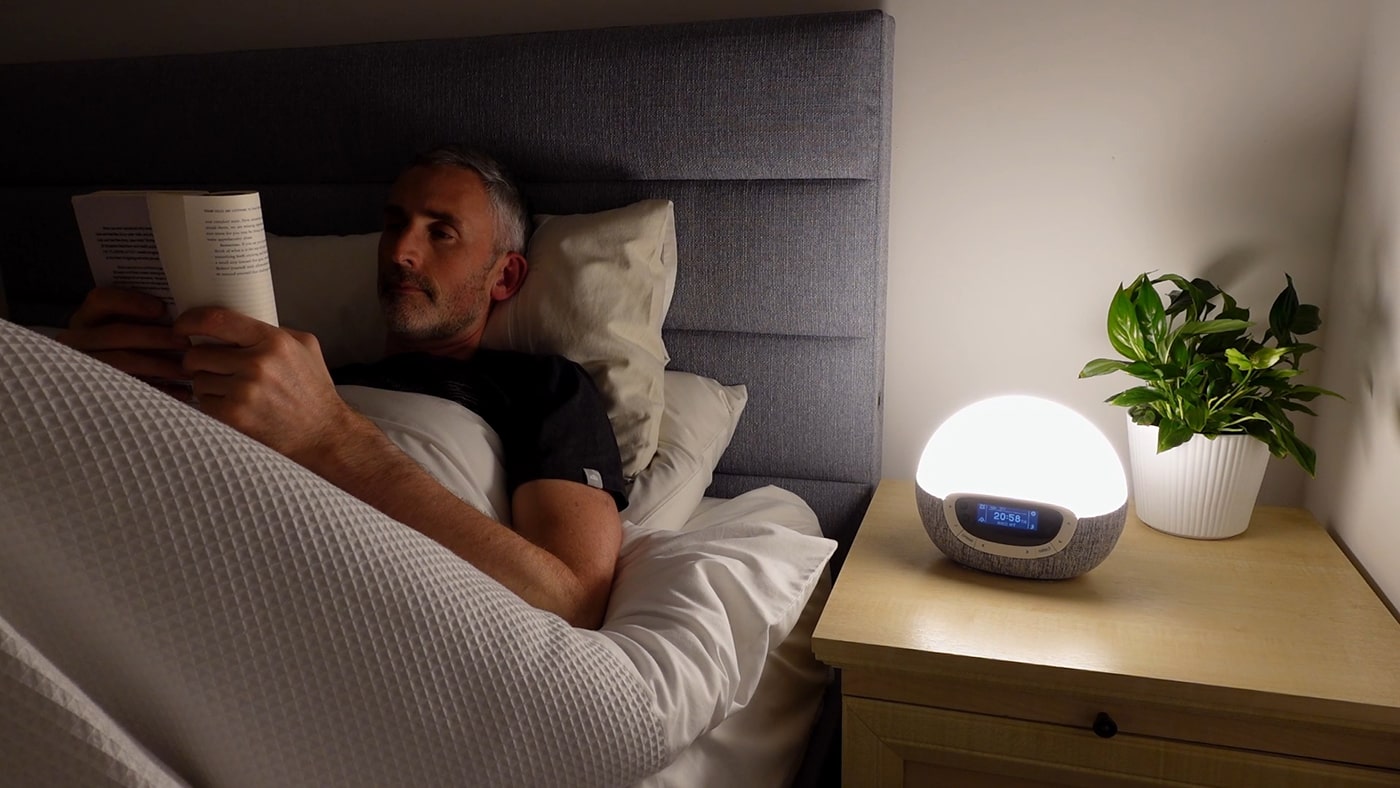
Introduction
The Lumie Bodyclock Shine 300 is a wake-up light that’s designed to help you fall asleep faster and wake up more gently in the morning.
It’s made by Lumie, which is a UK-based company that’s been making light therapy devices for over 25 years. It’s a class one medical device, which is one of the points that sets it apart from a lot of the budget wake-up lights sold online at the moment.
I bought it online for £109.99, so it’s not exactly cheap. However, Lumie does have some lower cost models as well as some more expensive ones.
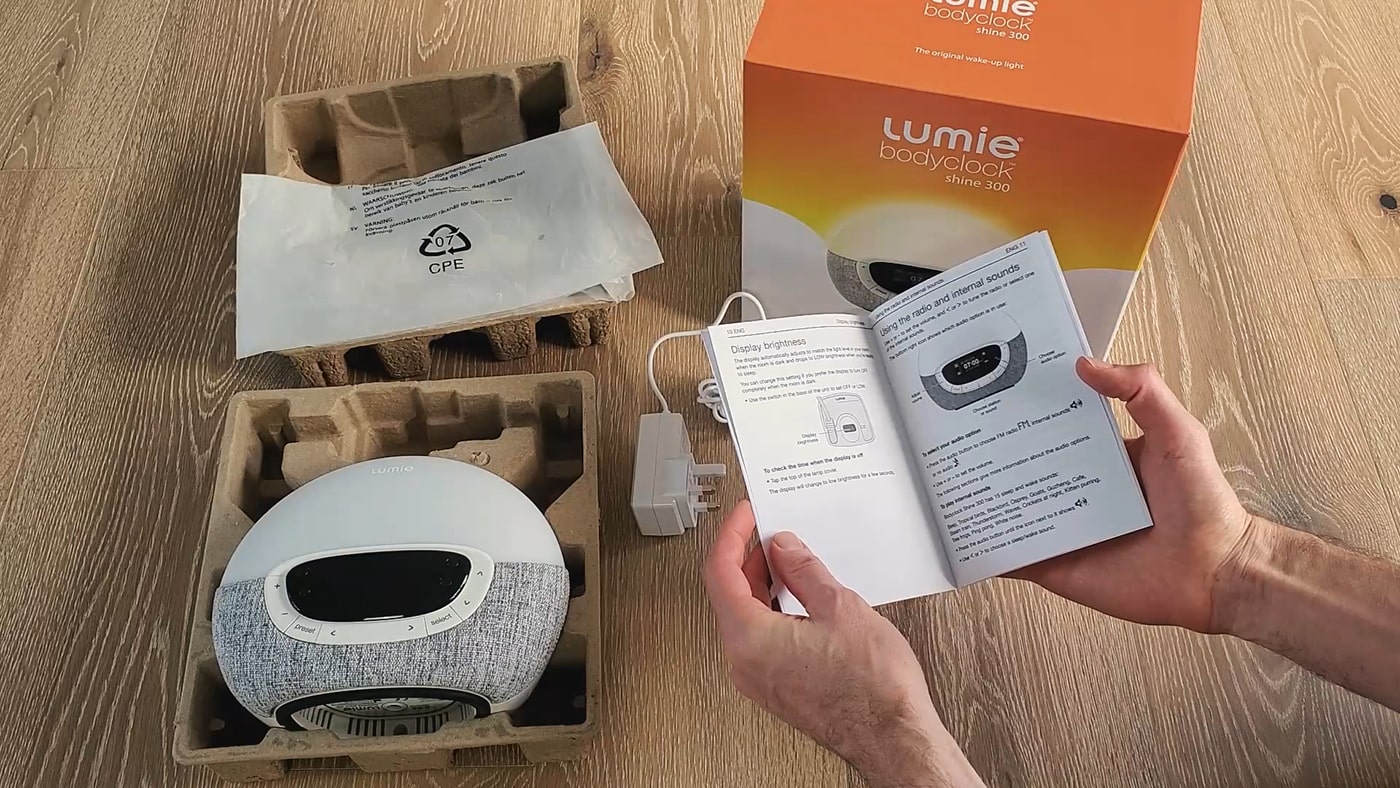
The core concept of a wake-up light
The core idea behind a wake-up light is that it’s supposed to help encourage regular sleep, help you fall asleep more easily in the evening, and wake up feeling more refreshed in the morning.
The idea in the evening is that the slow fading of the light with the sunset feature helps trigger your body’s melatonin production, which keeps your circadian rhythm in check and helps you fall asleep – ideally.
In the morning, the idea is that the light slowly fades from red to white, and is a more gentle way to wake up rather than by being jolted out of bed by a loud alarm clock.
Lumie also says that it may help with winter blues and seasonal affective disorder, though it’s not technically one of their SAD lamps, which they do make as well.
When I review sleep products, and I review a lot of sleep products, it’s very rare that I use the word ‘love’, but I do love my Lumie wake-up light. I’ve found it to be an excellent device, particularly in the nighttime; I really love the way the sunset works.
However, like all loving relationships, it’s not perfect. There are still a couple of gripes, so I’ll be talking about those as we go through this review. But for me personally, just from the outset I’m going to make it clear that this is a device that I really like.
Sunrise and sunset in action
(This section starts at 1:30 in the video)
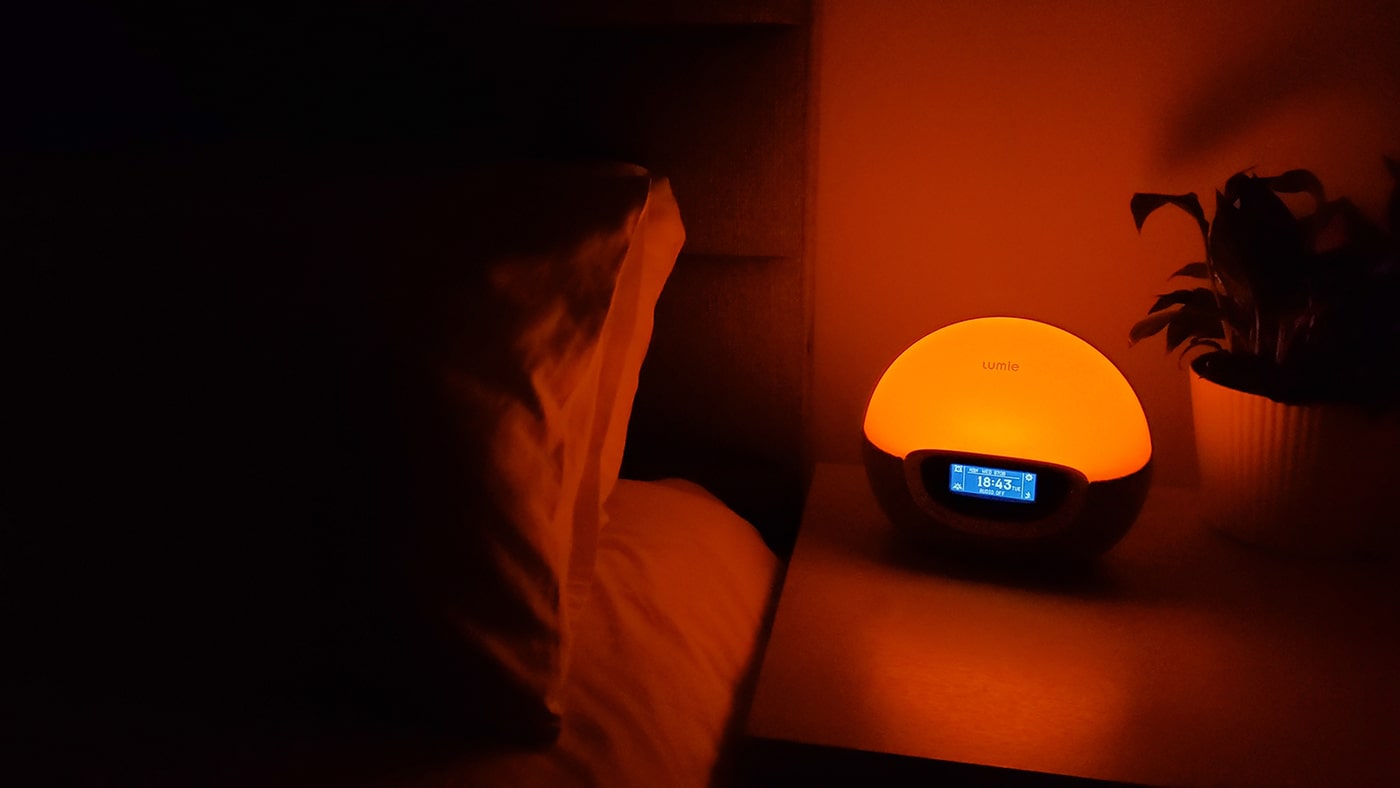
Note: I recommend watching this section in the video above if you’re able to, as the photo above doesn’t really do it justice. I took a 15 minute sunrise and sunset video, and then sped it up by 1500% in the video so you can see the colour and brightness transition over a shorter period of time.
Sunset
I like that you can choose the starting brightness and the time the sunset lasts, and choose to have it fade to off, or to a dim night light that stays on. What I love is the warmth of the colours, the slow fade from white to red, and the rich deep reds towards the end. I find it makes me feel very drowsy and I often fall asleep before it finishes.
Sunrise
There’s definitely something very pleasant about waking up as the light slowly fills the room. Since using it, I’m sure I’ve been waking up in a better mood most days. It’s just a nicer way to wake up than with a loud alarm clock.
It’s worth noting that the sunrise will start before your chosen alarm clock time. For example, if you choose to wake up at 8 a.m and select a 30 minute sunrise then the dimmest light will start at 7:30 a.m. When it reaches 8 a.m. the radio or the sounds will come on if you’ve chosen them.
I like the flexibility you have in controlling the way the sunrise and the sunset operate. There are different ways that you can control the intensity of the brightness, the time that it takes, what happens when it finishes, to have it just how you like.
Settings and features
(Starts at 2:52 in the video)
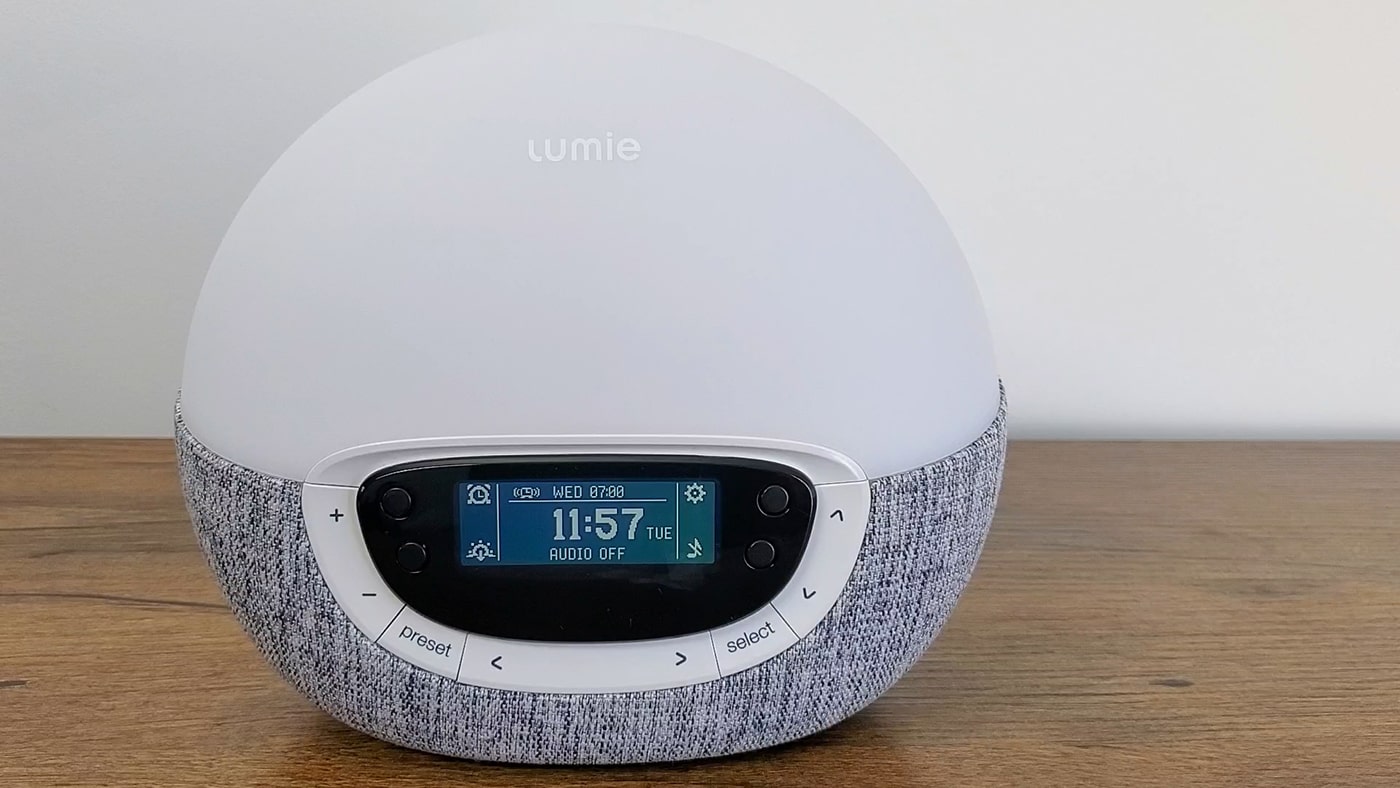
The first thing to say is that the manual is clear and comprehensive, which is good as there are enough settings to warrant 16 pages of instructions.
I’m not going to go through all the settings as that would take ages and turn this article into a long instruction manual, but I will give you an overview and some thoughts on the most important settings.
First of all, it’s worth pointing out that the display is auto-dimming, so it will change according to the brightness of your bedroom. Underneath there’s a button to turn it off at night if you prefer though. And if you do turn the display off, you can tap the plastic top of the light if you want to see the time at any time.
I know many people don’t like having and LED lights in the bedroom at night, so it’s great that Lumie thought of this and included a button to cater to people’s preferences.
Main settings buttons
The four small black buttons on the front are used to access the main settings, to select the sound option or turn it off, to activate or deactivate the alarm, and to activate the sunset.
In the main settings, there’s a screen to adjust the language, the day, and the time. There’s one for the alarm. One for the sunrise. And one for the sunset. It’s good that the display can be changed into nine languages.
Alarm settings
A feature I really like about the alarm settings is that there are two main options – weekly or daily. You can select one daily alarm time and then just tap the button to start it when you go to bed (or not, if you want to sleep in).
Alternatively, you can set a weekly alarm to change the alarm time for each day independently. This is a very useful feature for people who want a different alarm time on weekdays and weekends.
One issue is that you need to use multiple buttons to set the alarm, and they aren’t clearly labeled, so you need to follow the manual until you get used to which ones to use.
I’ve found that even after a few weeks of using it, I still sometimes press the wrong button to set the alarm. Even in the video, if you look closely you’ll see I press a button that does nothing a couple of times!
Sunrise settings
When you adjust the sunrise, you can select five minute increments from 15 to 90 minutes. You can also select the final brightness, and the alarm audio source if you want radio or the ambient sounds.
I usually just have the sunrise, but occasionally I’ll have the radio come on as well. The light part of the sunrise will start before your alarm time, and reaches maximum brightness at the time you selected.
The sounds will come on then as well, fading in slowly over a few seconds. It’s important to note that you can’t change that particular setup. if you do choose to have audio, it will always turn on at your chosen alarm time, not when the sunset begins 15-90 minutes earlier.
Sunset settings
The sunset is similar to the sunrise, just in reverse really, but there are a couple of key differences. For example, you can fade it to dark or to a night light setting of your choice.
You can have no audio at all if you prefer, or you can have radio or sleep sounds that turn off when the sunset finishes, or you can have it continue after the sunset but slowly fade out.
To start the sunset, you can press the little black sunset button on the front and it will start from the current brightness level you have it on. Note that you need to manually turn the light on, otherwise hitting the sunset button will do nothing. It’s a minor point, but one to keep in mind to avoid confusion.
Overall, I think it’s great to have so much freedom to fine-tune the sunrise and the sunset, but the buttons won’t be suited to people who prefer very simple, easy-to-operate devices. And you’ll probably need to keep the manual nearby for the first couple of weeks unless you’re an Olympic level Kinder Surprise assembler.
Having said that, once you get it set up and running, you don’t need to enter into the settings screens very often, and it becomes much easier to operate.
Reading light function
(Starts at 4:57 in the video)
A feature of the Lumie Bodyclock that particularly impressed me is the reading light. All you need to do is press the button to change the brightness level and it will stay on for up to 12 hours.
You can choose any of the incremental brightness levels to find the one that’s most comfortable to read or relax in bed with. For me, it’s a much warmer and more comfortable light to read with than my previous bedside lamp. So I’ve now removed that one and I’m just using the Bodyclock.
What I like as well is that when you do have the light selected and you’re ready to go to bed, you can just put your book down, hit the sunset button and it will start from there. If you prefer, you can change the brightness a little bit and start the sunset from that setting. So it works really well as a reading light and I’m using it all the time at the moment.
At the time of writing, the days are short here too, so I like to use the light from the lamp whenever I’m in the bedroom. Maybe it’s psychological, knowing that Lumie makes SAD lamps, but I can’t help feel that the warm brightness of the Bodyclock adds some much needed positivity into my bedtime routine.
One minor criticism is that because there are 20 incremental brightness settings, if you want the maximum one, you have to repeatedly press or long hold a button to get there. Perhaps an extra button to immediately jump to the maximum brightness would have been good to include.
Nightlight function
(Starts at 5:30 in the video)
If you prefer to sleep with a night light on, you can choose a dimmer setting and the sunset will fade to that color rather than darkness.
I don’t use that feature personally, but it’s a useful one for people who don’t like to sleep in the dark. The night light will stay on all night if you want it to, and you can choose the brightness and colour, such as a deep red or a warm orange.
The audio options
(Starts at 5:47 in the video)
Note: It’s best to watch this section in the video if possible, as talking about the radio and sounds in written form isn’t the same. I’ll leave it in though in case you can’t watch the video and want to know my view on the sounds.
The Lumie Bodyclock Shine 300 has both a radio and 15 sleep sounds. I do quite a lot of reviews of white noise machines so I feel like I’ve got a good understanding of what makes a decent set of white noise and nature sounds that you can listen to when you’re falling asleep or waking up in the morning.
I think the audio is one aspect of the Bodyclock that could potentially be a deal-breaker for some people. This is mainly because it doesn’t have DAB, just FM. So if you like Radio 6 in the UK, for example, you won’t get that as it’s only available on digital radio.
Furthermore, there’s no audio input so you can’t use the speaker to play your phone’s Spotify playlist for example. And finally, the internal speaker itself doesn’t produce particularly special sound.
However, it did win a Quiet Mark award specifically for not being a loud device that can interfere with other people’s peace and quiet in the surrounding area. So it’s worth bearing in mind that the Bodyclock Shine 300 isn’t designed to be a loud speaker.
The radio
(Starts at 6:36 in the video)
There are five radio station presets, which you have to manually find and save, and the display doesn’t name the station as it’s not a digital radio.
It’s slightly fiddly setting up the presets, as with most of the settings, and I would have liked to see five buttons – one for each preset to make it faster to choose between them.
The radio sounds okay, and I could get clear reception with the little wire antenna that comes out of the back. It lacks bass though, and the sound that kind of spills out of the speaker rather than flooding the room just isn’t as rich as most decent radios or dedicated audio devices I’ve listened to recently.
The sleep sounds
(Starts at 7:09 in the video)
There are 15 built-in sounds to choose from. I like that there’s so much variety – more than many dedicated white noise machines. Some of them are good, like the different birds and the thunderstorm; others are slightly dubious, like the ping pong and goats, which I don’t find relaxing.
Not including rain on its own is a miss too, as I know from my experience with white noise machines that pure rain is one of the most popular options.
I timed them on about a minute and a half loop, which is longer than a lot of white noise machines, so it’s pretty good in that respect.
Bodyclock Shine 300 ambient sounds
- Tropical birds
- Blackbird
- Osprey
- Goats
- Guzheng
- Cafe
- Steam train
- Thunderstorm
- Waves
- Crickets
- Kittens purring
- Tree frogs
- Ping pong
- White noise
- Beep alarm
As I’ve already touched on, my view is that the speaker quality just doesn’t match the quality of the light. It’s fairly quiet and lacking in bass, so although it’s acceptable for quiet listening in bed, if you’re an audiophile you might be disappointed.
And if you were hoping to use it to mask external noise like you would with a white noise machine, the low maximum volume means it’s no match for the more powerful white noise machines, or even a fairly basic Bluetooth speaker connected to a phone. So it really is a device for quiet listening in bed, and nothing more.
As I said, it’s a shame there’s no audio input or Bluetooth functionality, so you can’t listen to another audio device through it. If you don’t like the radio or the ambient sounds, that could be a deal-breaker for some people unless you’re happy to have another device on your nightstand just for the audio.
For me though, it’s really all about the light with the Bodyclock Shine 300, and the audio is just something that I use from time to time.
Despite my somewhat negative view of the audio, I do like the fact that you can choose to have the light on its own, or the light and the audio, or just the audio basically.
It’s good that they give you that flexibility, and if you are going to use it as an alarm clock then why not have some radio come on with the light in the morning? It’s better than having no noise at all if you’re a heavy sleeper and you don’t tend to wake up without any sound.
Specifications
- Medical device: class 1 in the UK
- Display: light-sensitive auto-dimming
- Lights: integrated LED – white, orange, red
- Height: 18 cm (7.1 inches)
- Width: 21 cm (8.3 inches)
- Depth: 12 cm (4.7 inches)
- Weight: 0.65 kg (1.42 pounds)
- Material: plastic, fabric
- Power: mains power adaptor, 1.8 meter cable
- Trial period: 45 days
- Warranty: 3 years
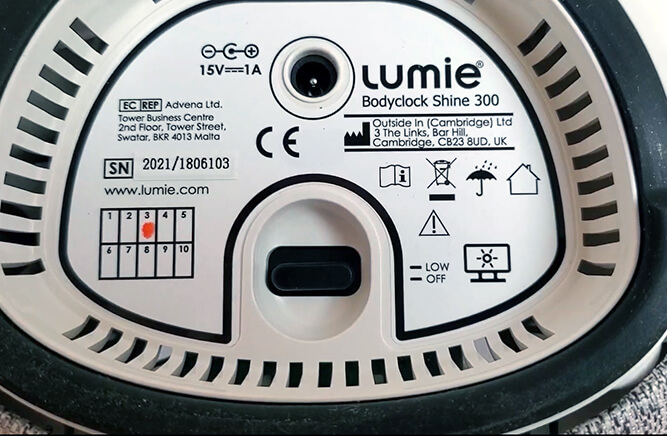
Pros
(Starts at 9:24 in the video)
Wake up light: the most important pro is that it works really well as a wake-up light. I like how the LED light fades smoothly from bright white to yellow, orange and deep reds. It works very well as a sunset simulator and also as a sunrise simulator. A lot of wake-up lights, especially the budget ones, tend to jump through the colors, whereas the Bodyclock Shine 300 has a smooth fading effect.
Features and flexibility: It’s a feature-rich wake-up light, and you get a lot of flexibility to adjust the settings just how you like them. It’s good that you can change the times of the sunset and the sunrise independently from 15 to 90 minutes in five minute increments. And there are many different ways that you can tailor the lights, audio, and timings to your own sleep schedule.
Daily or weekly alarms: you can have a constant alarm time, or change all seven days independently if you prefer. Many wake-up lights don’t allow that choice, so it’s another flexible option I appreciate having.
Design: the Lumie has an aesthetically pleasing rounded design. It doesn’t look too big on a bedside table as it’s relatively small and unobtrusive. I like the grey fabric wrapped around the front, which gives it a more modern look.
Light and audio: even though the audio will appear in the cons, it is good that it’s not just a light, but also includes audio options. Unless you have high expectations of your audio devices, it’s acceptable for relaxing in bed. And waking up to the sound of birds rather than a blaring alarm tone will appeal to many people I imagine.
Reading light and nightlight: the Bodyclock can easily replace both an existing bedside reading light and a nightlight if you have one. And it works even better than most normal bedside lights and nightlights in my experience.
Cons
(Starts at 10:34 in the video)
Price: it’s not a cheap device: I paid £109.99 for it in the UK. You can get wake-up lights for half the price if you don’t mind a more basic sunrise effect.
Audio: it would have been good to have a DAB radio built-in. The Bodyclock Luxe 750DAB does, but this one doesn’t – just FM. The maximum volume isn’t particularly loud either, which may or may not be a good thing depending on your point of view.
Buttons: the instructions are quite long because there are so many features and functions, and it’s tricky to work out how to use it at first. So if you’re not someone that likes poring through a manual and playing with different settings, this might not be the wake-up light for you.
Visual display: the display panel looks a bit dated. I think it could have been modernized a little. DAB radio, for example, would perhaps allow a name for the radio stations rather than FM frequencies. Having said that, the fact that it’s auto-dimming or can be switched off definitely helps offset the 1990s look.
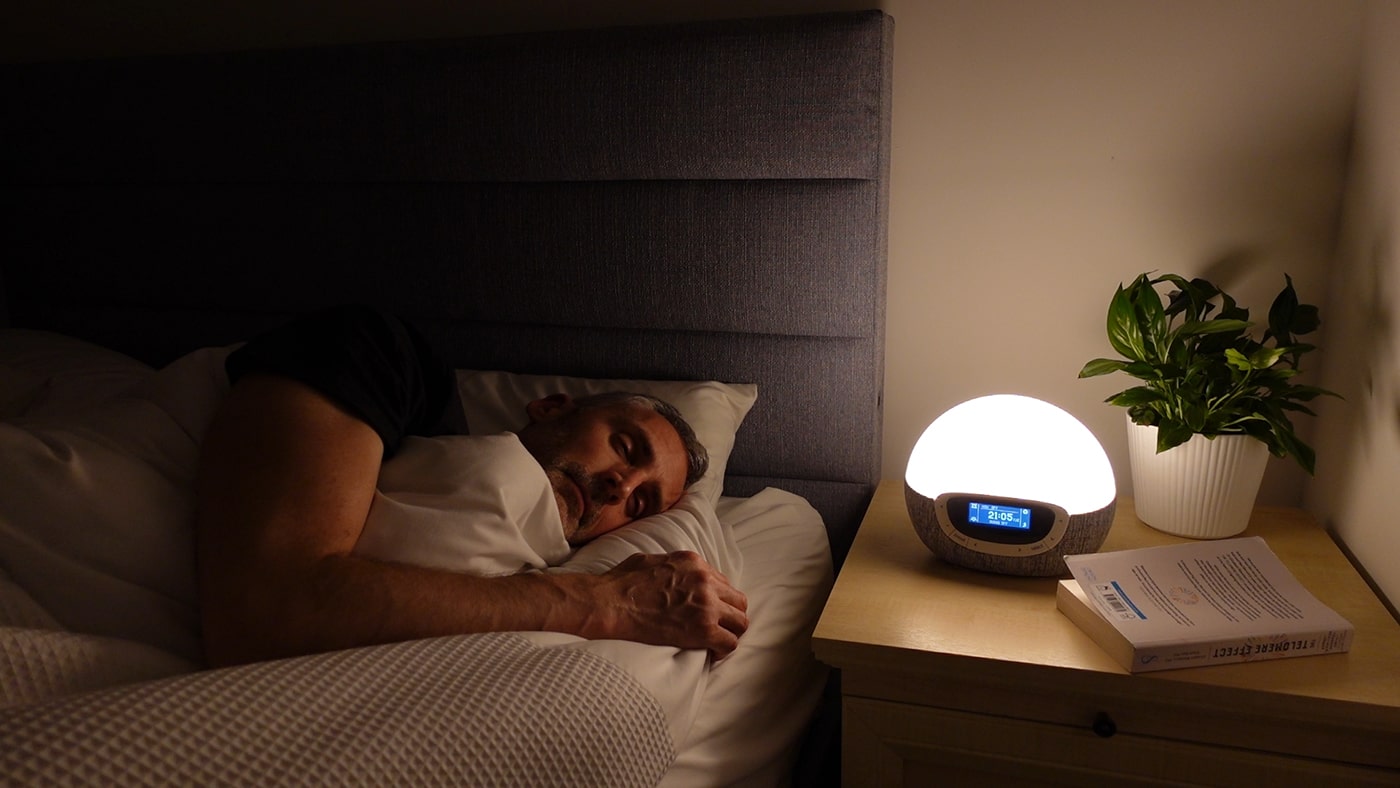
Final verdict
My final verdict is that as a wake-up alarm clock and a sunrise simulator, the Lumie Bodyclock Shine 300 is fantastic. I really like using it for those features and appreciate the control you get over the settings.
Sure, the audio is a bit underwhelming, and the instructions and the buttons aren’t exactly the most intuitive. But once you get to grips with those, I think it does its main job of helping you fall asleep and wake up more gently very well.

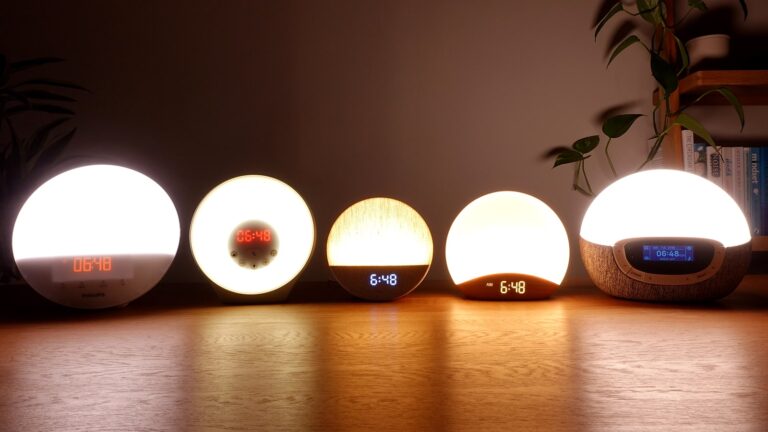
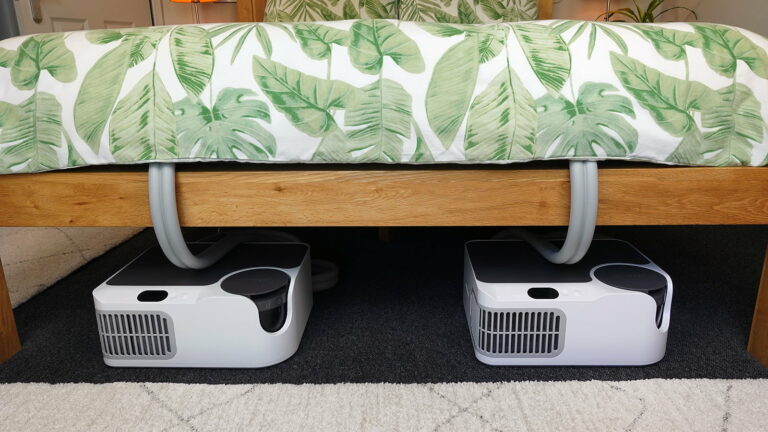
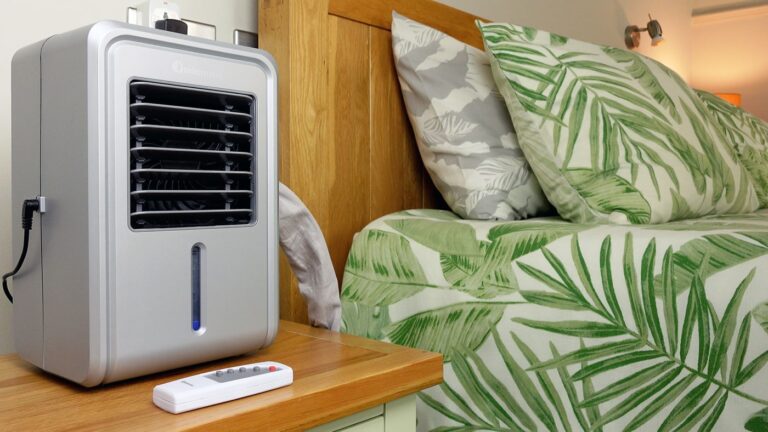
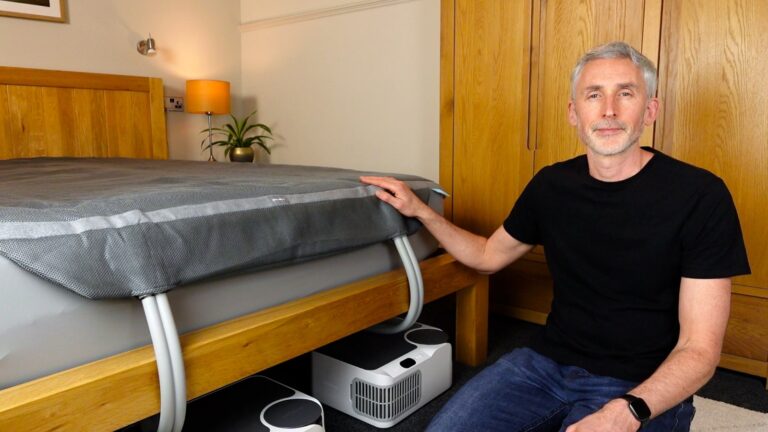
I’m seeing this a few years later, but I wanted to ask about the alarm turning off on its own. When it reaches full brightness and the audio starts, it shuts off fairly quickly and goes back to a dim red for a bit before repeating and sounding the alarm again. Is this normal, or should the light and audio stay on until I turn it off manually? Thanks! Hoping you’ll see this!
Hi Hannah,
That doesn’t sound normal to me. When you say repeating, do you mean the whole sunrise effect starts all over from the dim red, or is it just the alarm tone that repeats?
Regards
Ethan
I love the sunrise/sunset feature and I normally choose the blackbird sound. However, I cannot turn the alarm/light off by tapping the top of the Lumi. I have tried many times and in the end in the dark, I have to pull the plug out the socket!! What am I doing wrong??
Thank you
Hi Cathy
Sorry to hear your Lumie doesn’t seem to be working as it should. Have you tried tapping the top at different points during the alarm? I am just wondering if you’re trying too late after it’s finished the alarm time cycle? Have you tried just as it starts?
Regards
Ethan